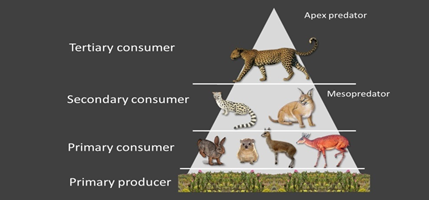Re-location of Cheetahs and the question of Biodiversity (Specials)
Context
The decision of relocating African cheetahs from Namibia to India requires much more analysis for conservation of biodiversity and Grassland ecosystem.
Background
- The fastest land animal in the world was declared extinct in the India.
- The country's last spotted cheetah died in Chhattisgarh in undivided Madhya Pradesh in 1947 and the wild animal was declared extinct in the country in 1952.
- It has been declared that it will be related in Kuno-Palpur National Park (KNP) in Sheopur district of Madhya Pradesh.
- The Kuno National Park, located in the Chambal region, has the right environmental conditions for hosting cheetahs.
|
African Cheetahs:
|
Need for a Relocation project
- ‘Reintroduction’ of a species means releasing it in an area where it is ‘capable of surviving’.
- Reintroductions of large carnivores have increasingly been recognised as a strategy to conserve threatened species and restore ecosystem functions.
- The cheetah is the only large carnivore that has been eliminated, mainly by over-hunting in India in historical times.
- The conservation of the cheetah will revive grasslands and their biomes and habitat, much like ‘Project Tiger’ has done for forests and all the species that have seen their numbers go up.
Analysis
What is the government’s strategy for the relocation project?
- As per the Ministry of Environment had in the 19thmeeting of the National Tiger Conservation Authority (NTCA) released an “Action Plan for Introduction of Cheetah in India”.
- The National Tiger Conservation Authority (NTCA) has decided to bring 50 African Cheetah from Namibia within the next 5 years to India.

Benefits of relocation
- Habitat conservation: Cheetah population forms keystone species in the grassland ecosystem. Its revival will conserve the habitat in dry forests in India.
- Grassland ecosystem: Governments plan to relocate cheetah is to conserve the dry grasslands which forms a major portion of India’s Central and Southern peninsular
|
Past success of relocation Project: Gaur translocation
|
The unexplored areas by the Conservationists:
- Unrealistic estimates: The estimate for large relocation is a bit illogical in such a small area.
- Cheetah in their best habitat exists in very less density as calculated to be 1 in 100 sq. km with average female density to be 750 Sq. kilometres.
- Resource diversion: The project will be a major distraction and divert much-needed attention and resources from priority conservation initiatives that are part of India’s National Wildlife Action Plan (2017-2031), which, by the way, does not even mention the introduction of African cheetahs.
- Potential for a success: The success rate of the relocation is very less and there exists a threat of failure of the project and resources.
- As, cheetahs are expected to establish themselves as a population in Kuno sanctuary after about 15 years.
- However, the area of Kuno palpur which is 748 sq. km can at best accommodate only about 10 adult cheetahs, against the estimated 21 adults by the government
Concerns associated with the relocation Project:
- Lack of Space for habitat development: Wild and free-ranging population of cheetahs will not be able to establish itself in India when there is no suitable habitat of sufficient size.
- Relocation Numbers estimated: The government has estimated to establish about 1000 cheetah in India, which is worrying as unlike other cats they tend to live in large spaces.
- Biological objective for Conservation: The basis for relocation is to conserve the grassland habitat; however, the aim will only be achieved when there is large numbers of cheetah adults.
Way forward
- Focus on conservation should be of species like Great Indian Bustard, caracal and Asiatic lion for Biodiversity conservation in Open grasslands and dry forests.
- Distribution of Cheetah in more spacious and other grasslands across India.
Conclusion:
The scientific foundation of the Action Plan to introduce African cheetahs in India is flawed. It also disregards our national conservation priorities and the rule of law as well as making exaggerated and unfeasible conservation claims.





